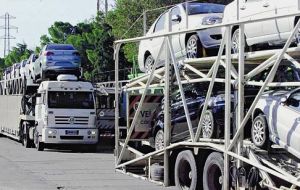MercoPress. South Atlantic News Agency
Argentina reaches surplus target but exports in September plummeted 27%
 There was a significant drop in car imports mainly from Brazil
There was a significant drop in car imports mainly from Brazil Argentine exports in September experienced their largest drop since the 2009 financial crisis totalling 6.818bn dollars or 12% less than the same month a year ago, according to the latest report on the country’s foreign trade released by INDEC.
Commodities sales overseas plummeted 27% in September mainly because of a poor performance by grains and oilseeds. Manufactured goods fell 10% with significant drops for the metal, paper and cardboard, printing and chemical sectors. Agro-manufacturing was down 6%, but fuel and energy was up 2%.
On the imports side, they dropped 14% compared to September 2011, the eighth month on a row totalling 5.905bn dollars. Intermediate goods were down 23% and consumer goods, 21%. Capital goods, fuel and lubricants slid 3%.
“Imports of passenger cars decreased because of lesser purchases, particularly from Brazil”, points out INDEC. Brazil is Argentina’s main trade partner and a leading market for manufactured goods.
With this result the Argentine trade balance in September enjoyed a surplus of 911 million dollars, which is 1% over the same month a year ago.
In the nine months the trade balance has accumulated a surplus of 10.9bn dollars, which is above the target for the twelve months and is equivalent to a 34% increase over the same period in 2011.




Top Comments
Disclaimer & comment rules-

-

-

Read all commentsAh, “points out INDEC” so how much do we add on to the deficit in real money?
Oct 25th, 2012 - 08:22 am 0Yes, we got an small surplus but, as imports are frozen (forbidden) so many industries are shut down or going to within the next months.
Oct 25th, 2012 - 09:48 am 0I thought that the idea of this was to help exports...? Suplus targets are obviously met (in % terms against imports) as imports are sort of banned...but exports down? this is not good news and is the opposite of what the government expected to happen
Oct 25th, 2012 - 11:17 am 0Commenting for this story is now closed.
If you have a Facebook account, become a fan and comment on our Facebook Page!